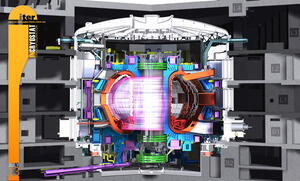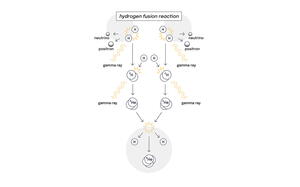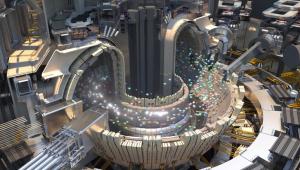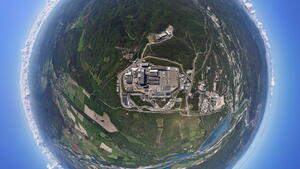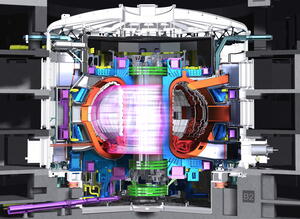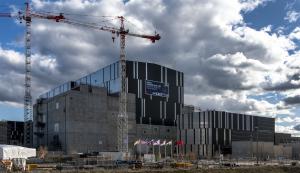In a Few Lines
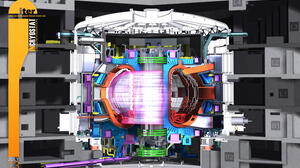
ITER ("The Way" in Latin) is one of the most ambitious energy projects in the world today.
What is ITER?
In southern France, 34 nations* are collaborating to build the world's largest tokamak, a magnetic fusion device that has been designed to prove the feasibility of fusion as a large-scale and carbon-free source of energy based on the same principle that powers our Sun and stars.
The experimental campaign that will be carried out at ITER is crucial to advancing fusion science and preparing the way for the fusion power plants of tomorrow.
The primary objective of ITER is the investigation and demonstration of burning plasmas—plasmas in which the energy of the helium nuclei produced by the fusion reactions is enough to maintain the temperature of the plasma, thereby reducing or eliminating the need for external heating. ITER will also test the availability and integration of technologies essential for a fusion reactor (such as superconducting magnets, remote maintenance, and systems to exhaust power from the plasma) and the validity of tritium breeding module concepts that would lead in a future reactor to tritium self-sufficiency.
Thousands of engineers and scientists have contributed to the design of ITER since the idea for an international joint experiment in fusion was first launched in 1985. The ITER Members—China, the European Union, India, Japan, Korea, Russia and the United States—are now engaged in a decades-long collaboration to build and operate the ITER experimental device, and together bring fusion to the point where a demonstration fusion reactor can be designed.
We invite you to explore the ITER website for more information on the science of ITER, the ITER international collaboration and the large-scale building project that is underway in Saint Paul-lez-Durance, southern France.
*Update 1 January 2026: The nations participating in ITER are the 27 member countries of the European Union plus China, India, Japan, Korea, the Russian Federation, and the United States. Switzerland is also a participant: after participating in the ITER project through the Euratom research and training program and the European Joint Undertaking for ITER (Fusion for Energy) from 2014 to 2020, it renewed its association as of 1 January 2026 with the European Union programs Horizon Europe, Digital Europe, and Euratom Research & Training (R&T) and became a member of Fusion for Energy, allowing Swiss researchers and industry to once again contribute to the ITER project. United Kingdom: Following Brexit, and the subsequent withdrawal from Euratom, the United Kingdom discontinued its participation in the ITER project. For the present, the ITER project is honouring any existing contracts with UK companies and research institutes but not concluding new contracts.
What will ITER do?
The amount of fusion energy a tokamak is capable of producing is a direct result of the number of fusion reactions taking place in its core. Scientists know that the larger the vessel, the larger the volume of the plasma ... and therefore the greater the potential for fusion energy.
With five times the plasma volume of the largest machine operating today, the ITER tokamak will be a unique experimental tool, capable of longer plasmas and better confinement. The machine has been designed specifically to:
1) Achieve a deuterium-tritium plasma in which the fusion conditions are sustained mostly by internal fusion heating
Fusion research today is at the threshold of exploring a "burning plasma"—one in which the heat from the fusion reaction is confined within the plasma efficiently enough for the self-heating effect to dominate any other form of heating. Scientists are confident that the plasmas in ITER will not only produce much more fusion energy, but will remain stable for longer periods of time.
2) Generate 500 MW of fusion power in its plasma
The world record for fusion power in a magnetic confinement fusion device is held by the European tokamak JET. In 1997, JET produced 16 MW of fusion power from a total input heating power of 24 MW (Q=0.67). ITER is designed to yield in its plasma a ten-fold return on power (Q=10), or 500 MW of fusion power from 50 MW of input heating power. ITER will not convert the heating power it produces as electricity, but—as the first of all fusion experiments in history to produce net energy gain across the plasma—it will prepare the way for the machines that can.
3) Contribute to the demonstration of the integrated operation of technologies for a fusion power plant
ITER will bridge the gap between today's smaller-scale experimental fusion devices and the demonstration fusion power plants of the future. Scientists will be able to study plasmas under conditions similar to those expected in a future power plant and test technologies such as heating, control, diagnostics, cryogenics and remote maintenance.
4) Test tritium breeding
One of the missions for the later stages of ITER operation is to demonstrate the feasibility of producing tritium from lithium within the vacuum vessel. The world supply of tritium (used with deuterium to fuel the fusion reaction) is not sufficient to cover the needs of future power plants. ITER will provide a unique opportunity to test mockup in-vessel tritium breeding blankets in a real fusion environment.
5) Demonstrate the safety characteristics of a fusion device
ITER achieved an important landmark in fusion history when, in 2012, the ITER Organization was licensed as a nuclear operator in France based on the rigorous and impartial examination of its safety files. One of the primary goals of ITER operation is to demonstrate the control of the plasma and the fusion reactions with negligible consequences to the environment.
What is fusion?
Fusion is the energy source of the Sun and stars. In the tremendous heat and gravity at the core of these stellar bodies, hydrogen nuclei collide, fuse into heavier helium atoms and release tremendous amounts of energy in the process.
Twentieth-century fusion science identified the most efficient fusion reaction in the laboratory setting to be the reaction between two hydrogen isotopes, deuterium (D) and tritium (T), as the DT fusion reaction produces the highest energy gain at the "lowest" temperatures.
Three conditions must be fulfilled to achieve fusion in a laboratory: very high temperature (on the order of 150,000,000 °C); sufficient plasma particle density (to increase the likelihood that collisions do occur); and sufficient confinement time (to hold the plasma, which has a propensity to expand, within a defined volume).
At extreme temperatures, electrons are separated from nuclei and a gas becomes a plasma—often referred to as the fourth state of matter. Fusion plasmas provide the environment in which light elements can fuse and yield energy.
In a tokamak device, powerful magnetic fields are used to confine and control the plasma.
What is a tokamak?
Power plants today rely either on fossil fuels, nuclear fission, or renewable sources like wind or water. Whatever the energy source, the plants generate electricity by converting mechanical power, such as the rotation of a turbine, into electrical power. In a coal-fired steam station, the combustion of coal turns water into steam and the steam in turn drives turbine generators to produce electricity.
The tokamak is an experimental machine designed to harness the energy of fusion. Inside a tokamak, the energy produced through the fusion of atoms is absorbed as heat in the walls of the vessel. Just like a conventional power plant, a fusion power plant will use this heat to produce steam and then electricity by way of turbines and generators.
The heart of a tokamak is its doughnut-shaped vacuum chamber. Inside, under the influence of extreme heat and pressure, gaseous hydrogen fuel becomes a plasma—the very environment in which hydrogen atoms can be brought to fuse and yield energy. (You can read more on this particular state of matter here.) The charged particles of the plasma can be shaped and controlled by the massive magnetic coils placed around the vessel; physicists use this important property to confine the hot plasma away from the vessel walls. The term "tokamak" comes to us from a Russian acronym that stands for "toroidal chamber with magnetic coils."
First developed by Soviet research in the late 1950s, the tokamak has been adopted around the world as the most promising configuration of magnetic fusion device. ITER will be the world's largest tokamak—twice the size of the largest machine currently in operation, with six times the plasma chamber volume.
See the Machine section for more on the tokamak and its components.
Who is participating?
The ITER project is a globe-spanning collaboration of 33 nations.
The ITER Members China, the European Union (through Euratom), India, Japan, Korea, Russia and the United States have combined resources to conquer one of the greatest frontiers in science—reproducing on Earth the boundless energy that fuels the Sun and the stars.
As signatories to the ITER Agreement, concluded in 2006, the seven Members will share the cost of project construction, operation and decommissioning. They also share the experimental results and any intellectual property generated by the fabrication, construction and operation phases.
Europe is responsible for the largest portion of construction costs (45.6 percent); the remainder is shared equally by China, India, Japan, Korea, Russia and the United States (9.1 percent each). The monetary (in-cash) contribution from each Member is small compared in-kind contributions: nine-tenths of the value of the project is delivered to the ITER Organization in the form of completed components, systems or buildings.
Taken together, the ITER Members represent three continents, over 40 languages, half of the world's population and 73 percent of global gross domestic product. In the offices of the ITER Organization and those of the seven Domestic Agencies, in laboratories and in industry, literally thousands of people are working toward the success of ITER. A recent review indicated that, with all contracting organizations included, individuals from 90 countries are working on the ITER site.
The ITER Organization has also concluded non-Member technical cooperation agreements with Australia (through the Australian Nuclear Science and Technology Organisation, ANSTO, in 2016) and Kazakhstan (through Kazakhstan's National Nuclear Centre in 2017); a Memorandum of Understanding with Canada agreeing to explore the possibility of future cooperation (2020); and a Cooperation Agreement with the Thailand Institute of Nuclear Technology (2018). ITER also has nearly 100 Cooperation Agreements with international organizations, national laboratories, universities and schools (see the full list at the end of the latest Annual Report).
See the Members page for links to the seven Domestic Agencies.
When will experiments begin?
On a 42-hectare site in the south of France, building has been underway since 2010. (See the Construction pages of the ITER web.) The central Tokamak Building was handed over to the ITER Organization in March 2020 for the start of machine assembly. The first major event of this new phase was the installation of the 1,250-tonne cryostat base in May 2020.
The ITER Organization is now overseeing the integration and assembly of components delivered to the ITER site by the seven ITER Members. This includes the assembly of the ITER tokamak, with its estimated one million components, and the parallel installation and integration of plant systems such as radio frequency heating, fuel cycle, cryogenic, cooling water, vacuum, control, and high voltage electrical.
Hundreds of thousands of assembly tasks, organized into construction work packages, have been carefully planned and organized by ITER engineers and schedulers. In its role as overall assembly integrator, the ITER Organization is assisted by several major contractors. (See the Assembly pages of the ITER web.)
Update January 2025: At the 35th Meeting of the ITER Council in November 2024, the ITER Organization presented a new baseline proposal to replace the plan that had been used as a reference since 2016. The new baseline prioritizes a robust start to scientific exploitation with a more complete machine than initially planned, with a divertor, blanket shield blocks and other key components and systems in place in time for the first operational phase. That phase—Start of Research Operation—features hydrogen and deuterium-deuterium plasmas that culminate in the operation of the machine in long pulses at full magnetic energy and plasma current. In the new plan, the achievement of full magnetic energy in 2036 represents a delay of three years relative to the 2016 reference, while the start of the deuterium-tritium operation phase in 2039 represents a delay of four years. Based on the analyses carried out so far by the ITER Members, the Council approved the overall baseline approach. The project is moving forward with the definition of project phases and gates, with associated milestones, for project control. More detail is provided in this article.)
ITER Timeline
2005 Decision to site the project in France
2006 Signature of the ITER Agreement
2007 Formal creation of the ITER Organization
2007-2009 Land clearing and levelling
2008 Component fabrication begins
2010-2014 Ground support structure and seismic foundations for the Tokamak Complex
2012 Nuclear licensing milestone: ITER becomes a Basic Nuclear Installation under French law
2010-2024 Construction of ITER plant and auxiliary buildings (excepting the Hot Cell Facility)
2015... Largest components are transported along the ITER Itinerary
2020 Machine assembly begins
2023 Completion of Tokamak Complex civil works
2024 Updated ITER baseline proposal reviewed by the ITER Council; overall approach approved
2033 Cryostat closure
2033-2034 Integrated commissioning
2034 Start of Research Operation
2036 Full magnetic energy
2039 Start of Deuterium-Tritium Operation

